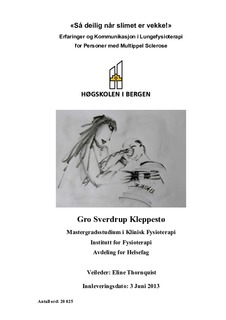| dc.description.abstract | Hensikten med studien var å få innsikt i erfaringer pasienter med langtkommet MS gjorde seg med lave lungevolum, slim i lungene og med fysioterapibehandling. Svekkelse i respirasjonsmuskulaturen og redusert bevegelighet i brystkassen fører til at pasienter med langtkommet MS står i fare for sekretopphoping i lungene og økt risiko for infeksjoner. Lungefysioterapi kan bedre respirasjonsmuskelstyrke, thoraxbevegelighet, lungevolumer og hostekraft, som igjen kan sørge for slimmobilisering. I tillegg ville jeg se på hvilken mening og forståelse som kunne tillegges signaler og reaksjoner som oppsto i samhandling mellom personer som har nedsatt språklig kommunikasjonsevne og fysioterapeuter. Kroppslig kommunikasjon er en vesentlig del av fysioterapeuters evalueringsverktøy og ligger til grunn for individuell tilpasning av behandling. Observasjon med filming av fire MS pasienter i behandling hos fire fysioterapeuter var bakgrunn for intervjuer med pasientene i etterkant. Dette store råmaterialet ga innsikt i pasienterfaringer og fysioterapipraksis som ble analysert med bakgrunn i fenomenologisk/ hermeneutisk forståelsesmodell. Presentasjon av empirien inneholder utstrakt bruk av beskrivelser fra observasjonene, og noe mindre fra intervjuene. Nedsatt språklig kommunikasjonsevne hos informantene førte til at intervjumaterialet var sparsomt, mens observasjonene var av uvurderlig nytte for utfyllende forståelse. Tekstnære kommentarer er knyttet til beskrivelsene, mens de i analyse og drøftingsdelen er forsøkt løftet til et høyere teoretisk nivå med kroppsfenomenologi, naturvitenskap og teori om kommunikasjon som bakgrunn. Pasientene var generelt lite opptatt av egen pust og lungefunksjon, og skilte ikke mellom vanlig fysioterapi og lungefysioterapi. De var heller ikke engstelige for at mye slim skulle hindre dem i å få puste, selv om de registrerte at det var lettere og bedre å puste etter at slimet var fjernet. Ingen av informantene husket behandling med intensiv lungefysioterapi fra de periodene de var innlagt på sykehus. Forstyrrende elementer i behandlingssituasjonen påvirket hvor fysioterapeutene hadde sin oppmerksomhet og deres sensitivitet overfor kroppslig kommunikasjon som blikk og pust. III Det kunne føre til misforståelser og gi mindre rom for individuell tilpasning og forståelse av hvordan fysioterapi påvirker mennesker som ellers har begrenset språklig kommunikasjonsevne. Studien viser at en erfaringsnær tilnærming kan gi uvurderlig informasjon fra fysioterapipraksis og samtidig belyse pasientenes mulighet til aktiv medvirkning. Det er nødvendig med adekvat faglig kompetanse for å imøtekomme stadig større utfordringer med alvorlig syke pasienter i førstelinjetjenesten. The purpose of this study was to attain in-depth understanding of the lived experiences of patients with advanced MS dealing with low lung volumes, airway secretions and physiotherapy. Respiratory muscle weakness and reduced thoracic mobility make people with advanced MS vulnerable to sputum retention and hence increased risk of infections. Respiratory physiotherapy may improve respiratory muscle strength, range of movement, lung volumes and peak cough flow to ensure sputum clearance. Also, I wanted to investigate if any comprehensive meaning and understanding could be ascribed to the signals and reactions occurring in the interaction between physiotherapists and patients with impaired verbal communication ability. Bodily communication is an essential part of the assessment tool in physiotherapy, and is crucial for individual adjustment of the treatment. Videorecording the treatment of four MS patients and their physiotherapists was the basis for interviewing the patients. This large amount of data was analyzed in a phenomenological/hermeneutic framework of understanding, based on the lived experiences of the patients and how the clinical physiotherapy was carried out. In the presentation of empirical data there is extensive use of descriptions from the observations, and less from the interviews. The interview material was sparse due to the informants´ impaired ability of verbal communication. The observations, however, were of valuable significance for complementary understanding. In presenting the empirical material, I have given low-level comments to the events in question, whereas in an attempt to lift the study to an analytic level of theory, the discussion is conducted with phenomenology of the body, science and communication as a basis. In general, the patients had little interest in their own breathing and lung function, and made no distinction between regular physiotherapy and respiratory physiotherapy. They were not worried that excess secretions could cause respiratory arrest, although they noticed that it was easier and better breathing after sputum clearance. None of the patients remembered intensive respiratory physiotherapy from their periods of hospitalisation. V Disruptive elements in the treatment setting affected the physiotherapists´ focus of attention, and also their awareness towards bodily communication such as gaze direction and breathing pattern. This lead to misunderstandings and provided less room for individual adaptation and understanding of how physiotherapy affects people who otherwise have limited verbal communication skills. The study shows that an experiencenear approach can provide valuable information from physiotherapy practice, and also illustrates the patients' possibilities to participate actively. It is necessary to provide adequate expertise to accomodate the growing challenges of seriously ill patients in the communities. | en_US |
